At Moogfest 2014, Moog Music today unveiled the new Emerson Modular System – a museum-quality reissue of Keith Emerson‘s iconic Moog Modular system.
Here’s what they have to say about the new system:
On the 50th anniversary of the introduction of the Moog Modular, the first voltage controlled synthesizer, Moog Music is proud to honor Keith Emerson and his seminal collaboration with Bob Moog.
Today, for the first time at Moogfest 2014, Moog Music reveals its three year effort faithfully recreating the iconic Emerson Moog Modular.
In the intervening 50 years since the advent of the first Moog synthesizer, people have steadily come to appreciate the power and flexibility of the early Moog modular systems. Now in 2014, 60 years after Bob Moog started his electronic musical instrument company, with great respect for the tradition, design, and craftsmanship of the original Moog modular systems, Moog Music proudly announces the recreation of arguably the most famous synthesizer in history–Keith Emerson’s Moog Modular System.
The Emerson Modular System
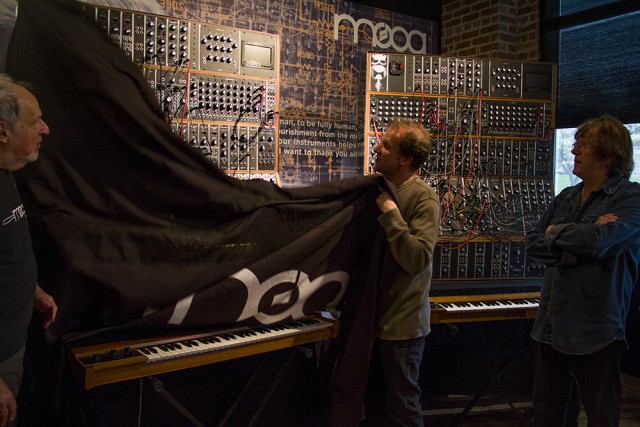
Over the last 3 years, Moog Music has set out to research and build a faithful recreation of this highly complex, custom instrument.

Moog modular specialists used the original documentation as well as circuit board and art files for nearly every original Moog module to faithfully recreate the original Emerson Modular System.
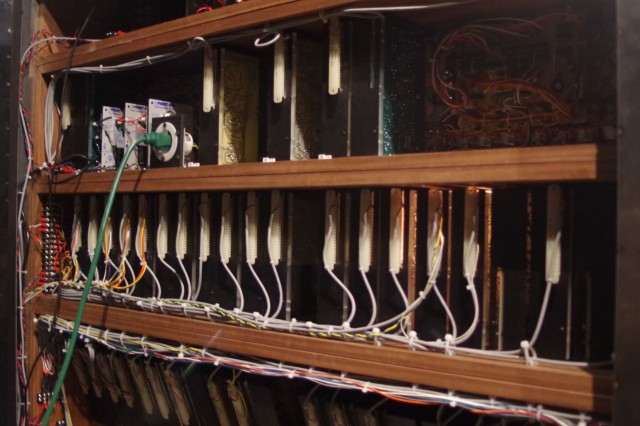
The Emerson Moog Modular System is made up of handcrafted Moog modules, built from the original circuit designs. They are true recreations of the originals, using the same hand assembly methods used in the Moog Music factory in Trumansburg, NY in 1969.
Many of the parts are new old stock. Moog modular guru Gene Stopp analyzed the original Emerson modular, reverse-engineered it and searched parts suppliers to find vintage components to match the original.
The modules in the new Emerson Moog Modular System are built by hand-stuffing and hand-soldering components to circuit boards, using traditional wiring methods. Even the front panels are photo-etched aluminum (a rare process now), which is the classic and durable look of vintage Moog modules.
The Emerson Moog Modular System is effectively a ‘new old stock’ modular monster synth. We were lucky to get a demo of the synth at the Moog factory, and it duplicates Keith Emerson’s modular down to the smallest detail – retaining the ‘quirkiness’ of old-school pots and components.
As a point of reference, here’s Keith Emerson explaining his original system:
And here is Emerson demonstrating his original system:
http://www.youtube.com/watch?v=dxTShKhAm74
Emerson Modular System Photos:
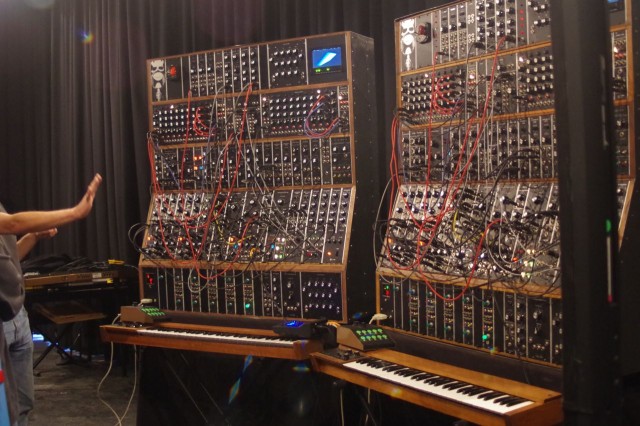
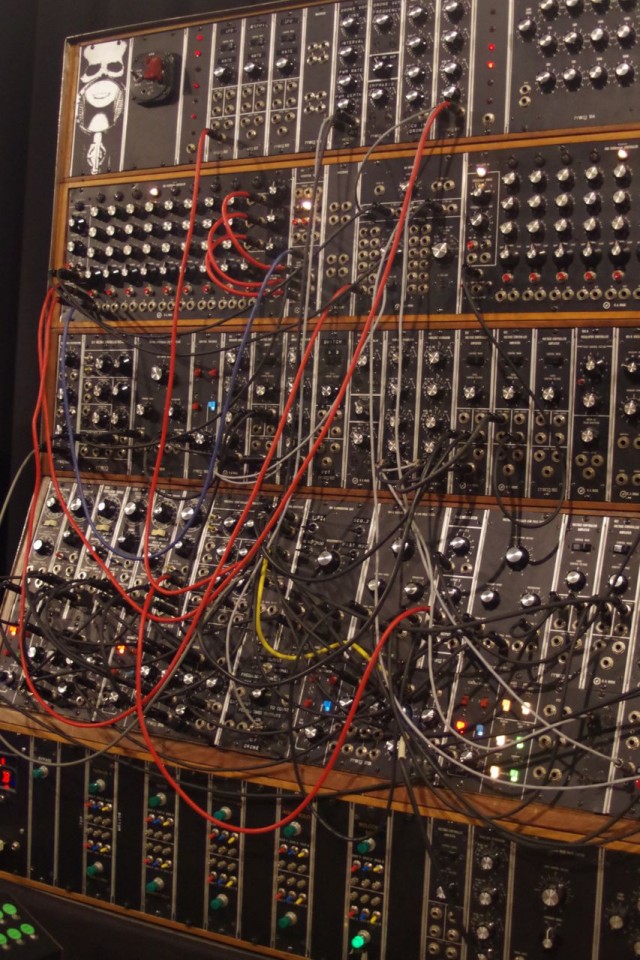
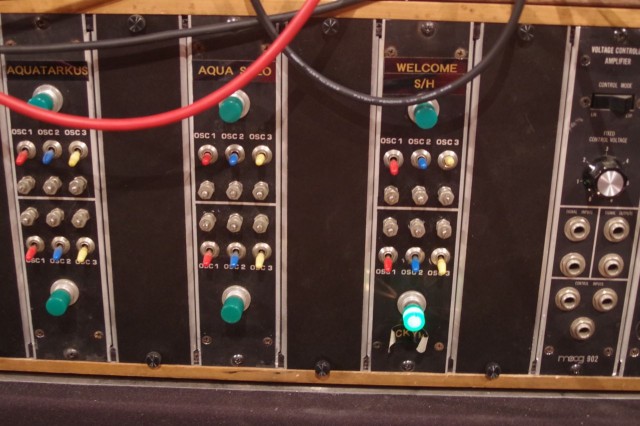
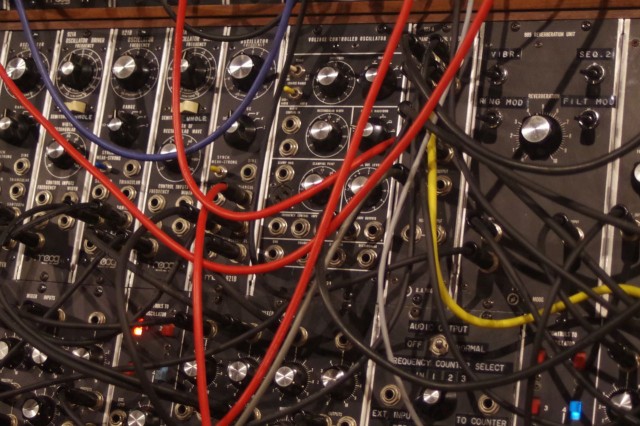
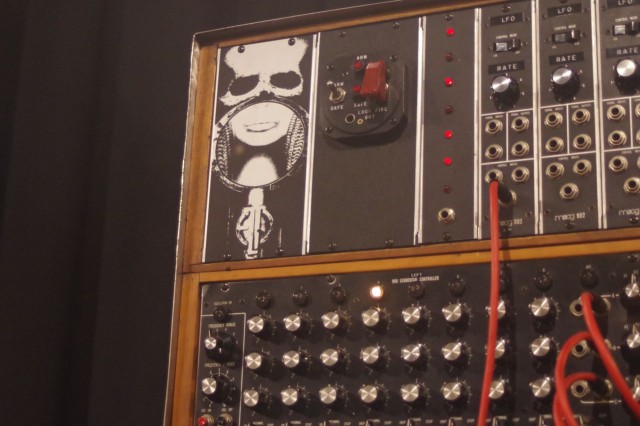
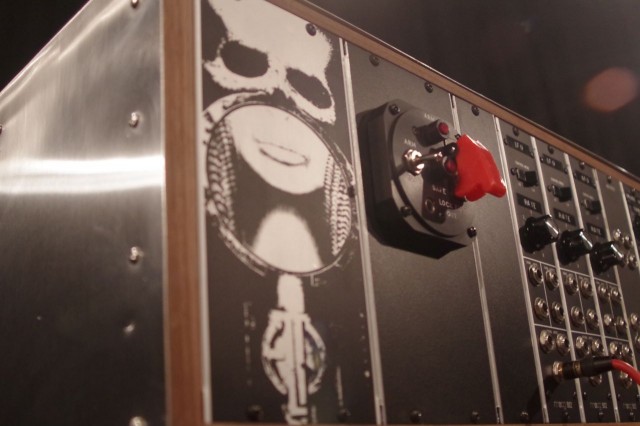
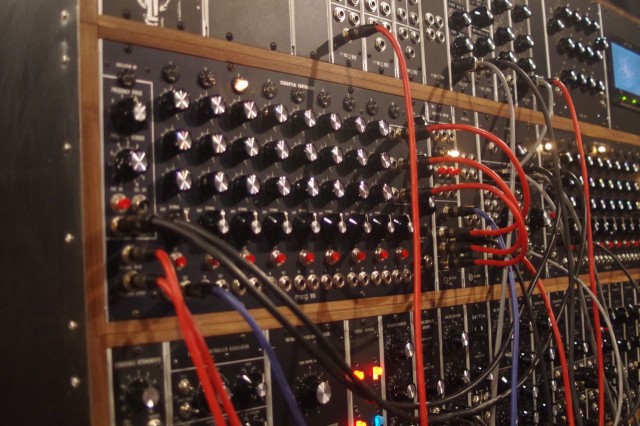
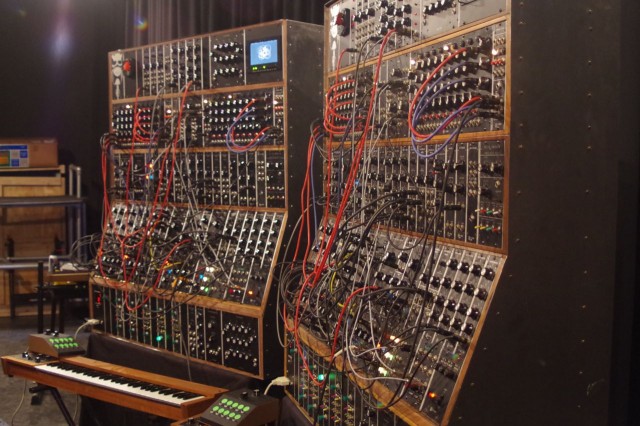
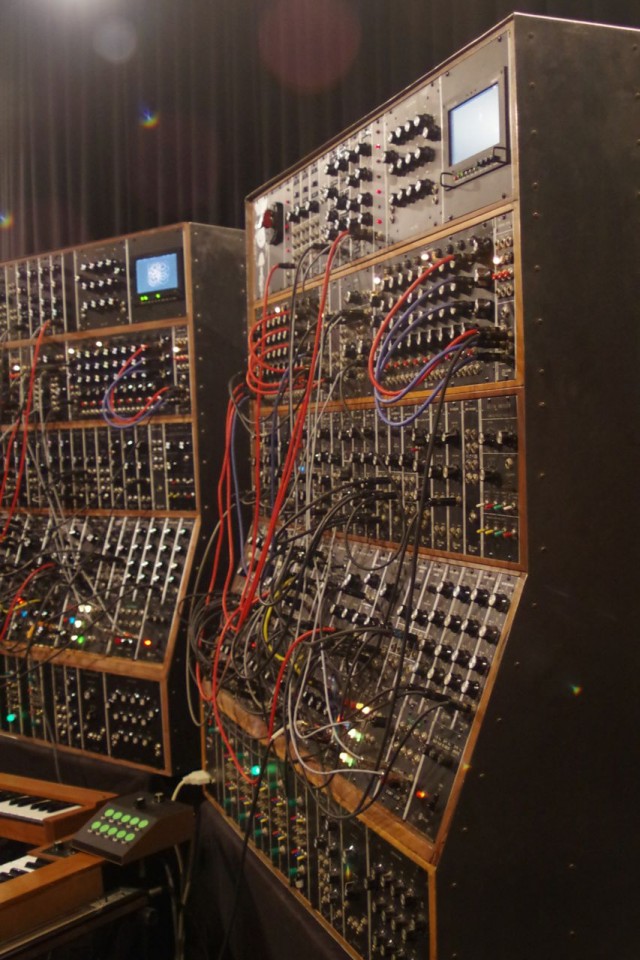
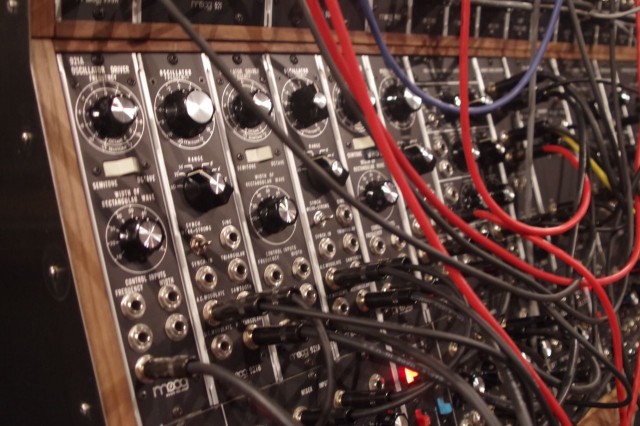
Moog Music, partnering with Emerson, plans to build a handful of the Emerson Moog Modular Systems. Pricing has not been announced, but if you have to ask…..
To inquire about the new Emerson Moog Modular System, contact Moog Music, at 828.251.0090.
Check out this beast and let us know what you think about the Emerson Moog Modular System in the comments!
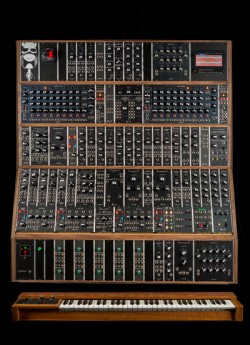

I’ll take two… for stereo.
It is amazing how much exquisite engineering they’ve done to create this. I’m sure it helped the current staff learn from Bob Moog and will inspire them to many more amazing products of the original moog quality.
My hope would be that from this project they develop an affordable modular system of this depth – if it happened to be euro rack compatible so much the better. I know fans have been wanting something like this for a long time, where better to research how to do it than with Emmersons modular?
The disliker is so poor…he not even can afford two of them 😀
Time to sell the house! This is insanely cool. I’d love to be able to go to a studio have have an afternoon with this!
I hope that they got Keith to play the two synths in stereo!
Waiting for the “whaaa whaaa why don’t they make a polysynth?” crew to jump all over this.
Don’t be a dick.
yeah!
Don’t be a Richard!
He isn’t a dick, he just points out who the real dicks are always crying like babies for stuff being totally offtopic.
Whatever, Orwell…”I wasn’t speeding, officer – I was just pointing out who the real speeders are by driving just like one!” I like it. You’ve both set a nice new precedent…this will be fun.
Yeah, why make a product that people are clamoring to buy when they can spend 3 years doing this!?
WWBS?
Because the people clamoring to buy a polysynth have no concept of what a reasonably-priced analog polysynth would cost. So not only would 90% of the “clamorers” end up NOT buying it, but the 10% who did would bitch and moan about how difficult it is to use/maintain. They assume it would be like having a digi-poly synth, except with that ANALOG SOUND! YAY! Okay, shucks no presets, but everything else would function the same, right?
No. That’s a fantasy.
It would be a PR disaster for the manufacturer, and it wouldn’t even be their fault. It would be the fault of the ignorant customer who just wants what they want without knowing how difficult or costly it would be to execute.
Ever hear of a guy named Dave Smith?
no who’s that?…
Let’s consider the most affordable of DSI’s “poly-analogs”: the Tetra. ooooh, 4 voice polyphony. For $800 retail. In a digi-analog hybrid. With no external inputs. And only a low-pass filter. No keys, not “enough knobs”, charge extra for the software editors… wowzers. You showed me. Though I do LOVE the tetra, it’s just not what most people mean when they say “an affordable polyphonic analog synth.” Even if it qualifies as such.
I’ll refer you to a comment by user “truth” a few posts above, and leave it at that….
good point…
There is a big difference between how DSI and Moog define analog. DSI synths use digitally controlled oscillators (DCOs), and really could be considered analog/digital hybrids. Moog on the other hand is one of the few manufacturers to still use voltage controlled oscillators (VCOs) in all of it’s synths. VCOs are more expensive to manufacture, take up more space, and are harder to control. This means building a poly synth that is fully analog in the Moog would be difficult and expensive. The original poly Moog didn’t use VCOs, but instead used oscillators similar to those found in transistor organs. Today however Moog tends to try and stay close to the true paradigm of their sound, and as such probably won’t be using DCOs in any of their synths… much less transistor organ oscillators.
If you absolutely have to have a true polyphonic analog synth, check out the Schmidt eighth voice pro. It’s only 20,000$!
Actuallly the Polymoog did have two real VCOs, but yeah, they were divided down for polyphony.
One got the osc vs osc beating, but little control other than modulation.
Regardless, I don’t see a problem with Moog making a 6 voice 2 VCO (12 vco) synth. It’s not a Memorymoog or even a JP8. Something like a Moog JP6 would be welcome.
Finally, Moog doesn’t (or didn’t) need 3 years to figure out how to make a Moog modular. Much of the KE Moog are custom modules and early revs. Others have figured it out. Saying they used the KE clone as a learning exercise is stretching things a bit.
I figure it’s the only way they could think of to make about 10 synths for close to a million dollars and so they did it. But I personally wouldn’t want a synth I had to plug a bunch of patch cables into specific places just so I could play a handful of ELP sounds. The fake screen, module-less holes, hand breadboarding and all that don’t help them release a modern day Moog modular.
I think it’s a PR stunt and quick way to make a bundle by old and rich ELP fans. Simple as that.
the screen is very real and fully addressable/operable
I agree on the analog-polysynth uproar. Its basically not practical, partly because it would cost the Moon to do well. I’d like to encourage people who are newer at this not to sweat over it. I’ve owned a MiniMoog and had the pleasure of laying hands to some classics like a Jupiter-8. The recreations over time have been so close, I laugh at the arguments. You get a fair deal that borders on effing magic when you can buy an accurate software version of a then-$5000 flagship for $200 or so. This Moog will be highly unrealistic for most of us, for a lot of reasons, but if That Sound has you in its grip, you can have it in several forms. Its fun to drool over the gear, but don’t let it bog you down. You’re already in the club.
Actually it does have presets. Scroll to the bottom of the page and look for the photo with three small modules labeled Aqua Tarkus, Aqua Solo, Welcome S/H. The modules with two sets of three switches and tuning pins are basically, a Minimoog VCO. Welcome’s activation light is on, oscillator is active. Signal is routed to the upper section which houses the VCF and VCA modules. A Sample and Hold generator produced the bouncing, pinging sound. ( As in Edgar Winter’s Frankenstein ) When you see Keith moving knobs on the upper unit, he’s controlling modules shaping the sound produced by those ” preset ” oscillators. This was such major cool stuff back most people don’t realize it. Players are spoiled by our digitally controlled boards these days, and I’m one of them. Please appreciate what this recreation represents.
Kudos to Moog for taking on a project that’s this insane!
What I want to know is what this leads to. Will they be reintroducing Moog modules? Hopefully in something more bite-sized?
Does this make Synthtopia the Top Gear of synthesizers (i.e. reporting on supercars that everyone wants but no one can afford)?
They originally announced this on April Fools Day. I am very surprised this is real. Awesome though.
Double fooled!
Yawn. Let’s all soil our shorts over 40 year old tech. It’s old! And analogue! This is the sad synth equivalent of blues dads and their ‘vintage’ starts. Terrible.
Maybe. But almost everyone will stop to admire a nice vintage car. Sometimes old is beautiful.
Crazy cool! 🙂 A handful only to be built though – kinda understandable however, but as TJon said, it might be interesting to see if they market the modules individually again.
Any guesses as to the cost of this monstrosity???
Love the fighter jet styled on switch toggle.
I found an April 1st article that quoted “about $90,000”
Which means likely over 100k
That’s what they said it cost them to build it – you gotta think $150,000 to make it worthwhile for them to build this.
Beautiful. If Moog wants to consider me an endorser, I’ll take one.
I was scrolling down to find the price, and the first digits I spotted was a phone number…
Which said $828.591.0090 😉
That’s probably pretty close.
I wonder what the pricing is going to be like in comparison to the 200e systems, there’s going to be the true modern day East coast vs West coast rivalry commencing!
This is a stunning beast! I will have to settle for VA’s cause my cute OPUS 3 doesn’t quite deliver that sound lol(nor was it Bob Moog designed). The preset modules would have come in handy at my first university’s (Jacksonville University) Elecronic Music class!
This is pretty interesting …if you’re an extremely wealthy, retro obsessed, modular noodling, extra room having kind of person.
This whole ‘remake the retro classics’ trend is really really boring to me. *just my opinion*
That would be because you go by your eyes, not by your ears…
You are too cool for school.
One hundred million dollars.
Keith Emerson? Nah! I’m anticipating Tangerine Dream’s Chris Franke’s reversed engineered Moog Modular next. It’s about time TD reformed with the classic 1975 line-up and did a series of cathedral gigs? 😉
Chris’ synth was made mostly of PPG and Projekt Elektronik modules.
Inside the PE filters were even Arp encapsulated filters.
Hardly a Moog clone, though it had some Moog modules.
(Ed Buller’s “Moog” is a true clone – not Moog, but looks like a Moog at a distance. Up close you can tell most of it’s not real Moog.)
What TD did right though were the PE sequencers.
They were all quantized selector switches set to chromatic intervals.
Based on the Moog 960, but done for real-time performance.
Nothing else came close at the time.
I don’t know, I hate to be a nay sayer, but they are a little late to the party they threw in the first place! With Moon, modcan, synthesizer.com, and others, why shell out thousands for the name? It’s not like they’re inventing anything revolutionary new or groundbreaking that hasent been finely reproduced by those synth makers? Although If I had the cashola…or was Hans Zimmer, I’d buy that sexy beast in a hot second!
I’ll have to ask is why? Why that synth? Why not produce modules for sale? Why does a small company with a handful of employees (several underpaid) build an effigy like this? It’s an admirable accomplishment, but why?
Because it is there.
Because it’s crazy.
Because Emerson still tours and his original Moog is priceless.
Because the project will teach them a ton about their past.
Because the guys that know this stuff won’t be around forever.
Because I can dream, can’t i?
Because it will help them figure out the logistics of making new modules.
Feel free to add to the list!
It makes complete sense because it doesn’t make sense from a logical but generalized business venture … come on, us synth nerds (if this insults you then move on, it doesn’t apply to you.) are a bit obsessive and get a little crazy over our gear. This is a good thing … we’ve got passion.
I just wonder if Moog is considering introducing individual modules … the interest/attention that the tribute modular gets just might be the tipping point for a future module production line 😉
cheeriOH ~ pulsewidthmod/maeghan
That’s one lucky man
stuff for Hans Zimmer only…
Some one mentioned the cool ” on ” switch. That’s not the on switch, that’s the pyrotechnics arming control for Kefs system. Though recreated on the new Moog system, there are no pyrotechnics fitted to the new system. As for Mr Zimmer he has quite the impressive modular Moog back wall setup at his studio.
I’d like Apple to redo the Apple 1. Or would I really? Even if I have always loved the Ford Mustang of old, I wouldn’t want an exact replica of it today.
But this is clearly a project made for a higher purpouse than commercial success. Some would even say the same about the Minimoog Voyager.
What is frightening today is that many, many people wouldn’t even have the slightest clue of who Keith Emerson is. Perhaps it should be sold together with a precise wax model of him as well.
I would say that the sounds of the past are awesome, but not the methods.
People want iMacs today, they want the new Ford Mustang design and they want synthesizers to be smart, modern and affordable. Like Animoog and the little hardware synth bass module.
But some people are crazy enough to love the old methods. And that’s where we see genius.
Or madness. 😉
(For myself, I’m buzy rediscovering my Roland Juno 2 and I call that vintage) 😉
Your analogy to the Apple I is very good and to me, makes no sense either.
The owner knows it’s a clone. If he’s honest, the friends he shows it to knows it’s a clone.
Now what? It has no disk drive, much memory and all that.
It can’t do much at all.
That’s where my head is at. Why clone something just to have a copy, especially such a crude one?
For $90K, I could have a modular that would run circles around Emerson’s modular.
wow, you are actually putting this down, because it doesn’t have memory or a disk drive??? What are you even doing on this site?
No. The analogy was to Apple I computers.
Nothing was said about the synth having disc drives.
I’ll take one. I trust that nice Mr Emerson will spend a couple of weeks at my home teaching me how to play it? He’d be very welcome.
Amazing. Hopefully Moog uses this limited run to figure out how to do modular again for everybody. I’d love to be able to add some Moog re-issue modules to my setup… especially if they incorporate the new moogerfooger designs.
Ooooooh! It’s so big!
Makes ya want to click on a thumb like you’re significant, huh?
For something like $150,000 – if that is indeed what it sells for – I find myself seriously tempted, as an investment. Who knows what it might be worth in 10 or 20 years?
Yes, it might be worth $500,000, or $50,000. Big risk.
My first thought was $250k ….if it did cost $90k each, you need to multiply cost by 2.5 just to stay in business, so my initial gut price would be close. Someone said original cost for that base system was$8 k in 70s, which would be $35k today, and that would be double the price of the largest competitors system, synthesizers.com. You can buy a massive modular from them today for $15k or so. But it would not be a moog, and it would not have the Emerson endorsement value. At any price, there will be a waiting list, crazy as it seems.
True. They will sell as many as they make, at whatever price they charge.
I’d love to have one of these–first check out the orignal if possible, then try the new one. Will they be building more of them? If so, I want one!
I guess the cost and time spent on this will be offset by the profits from the zillions of Thereminis they’ll sell – which reminds me, I ordered mine weeks ago – where is it?!
I am nearly in tears. This is amazing. I knew it was coming but still… wow.
The: ‘can we have an affordable poly modular’ question rears its’ head again. However, it’s a question already answered by Analogue Systems in the UK. their PolyHarmonic Generator is a single module that fits nicely into the EuroBox format, offers six note polyphony by four sources deep and has a positive synthesis way of generating tones – a bit like a Hammond. It may not be everyone’s glass of Malvern Water but it does allow me to have a traditional modular – in EuroBox format that doesn’t look as pretty as the Moog but let’s you get a lot of modular into a small footprint and to add polyphony in one module.
after reading some of the comments I am more than positive that majority of the negative comments are from people that have no interest or just couldn’t afford it anywayand if he actually read the article it was being produced as a museum piece with posibilities that a few more may be produced if people are interested in paying for it.me personally I’m in electronics geek and I don’t care what anybody says it looks like the coolest thing in the world peace out b******
“…being produced as a museum piece” <- Yeah. if I were to buy one of these as an investment, I'd try to arrange to loan it to a museum for 10 or 20 years, let them display it and occasionally use it. Whether or not museums will do this kind of thing, I don't know. But the concept appeals to me.
Here’s the a video of the full announcement I took for those that are interested.
https://www.youtube.com/watch?v=CTf2U8eRHCo
/ Hami
RIP Keith, thanks for the music. So proud to have been involved in making this system a reality. All the panels for this were made in my tiny workshop in the UK. I took all the available artwork and created new production masters for the panels. Some were in a terrible condition, shrunken, distorted or scratched and none were suitable for direct use. A few designs had no original films available, but I had layouts for many, or we scanned Keiths panels and then created digital files for producing new films for the etching process.